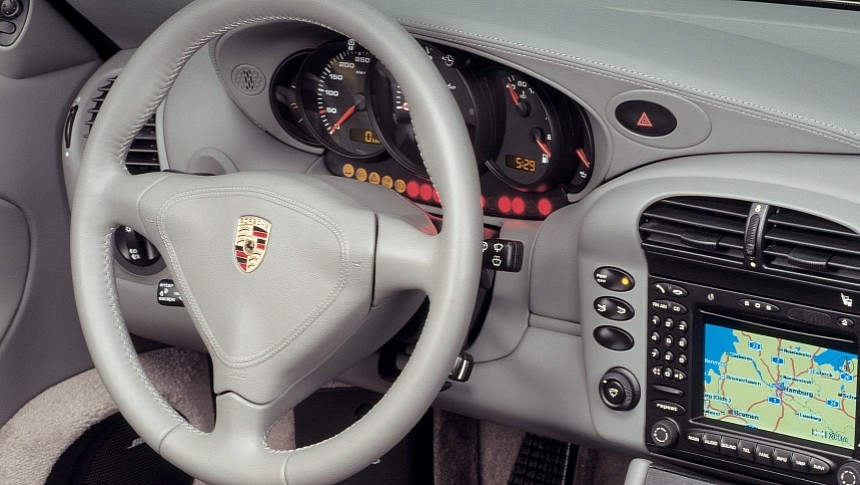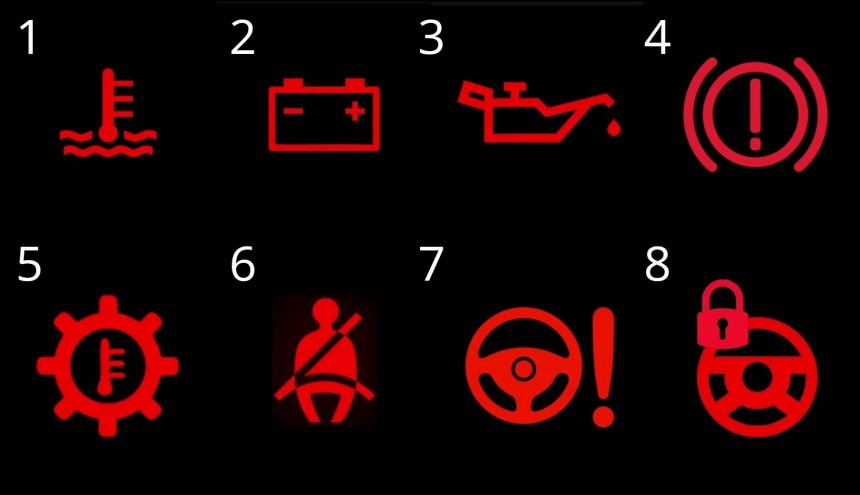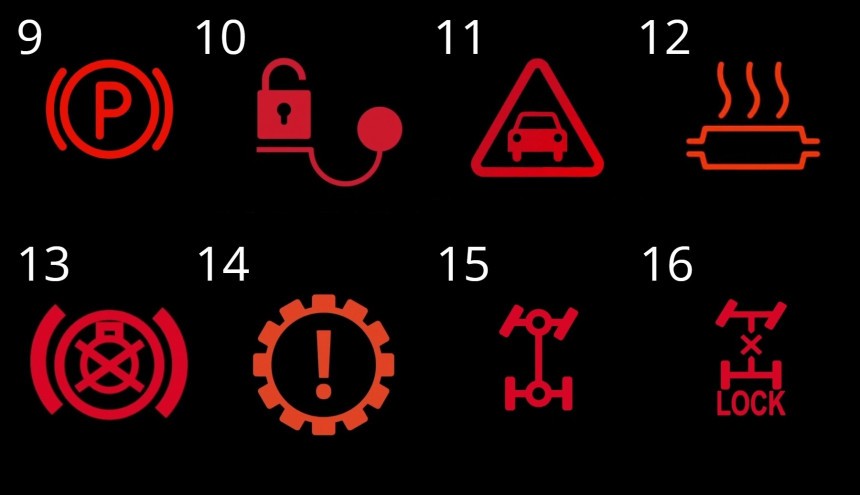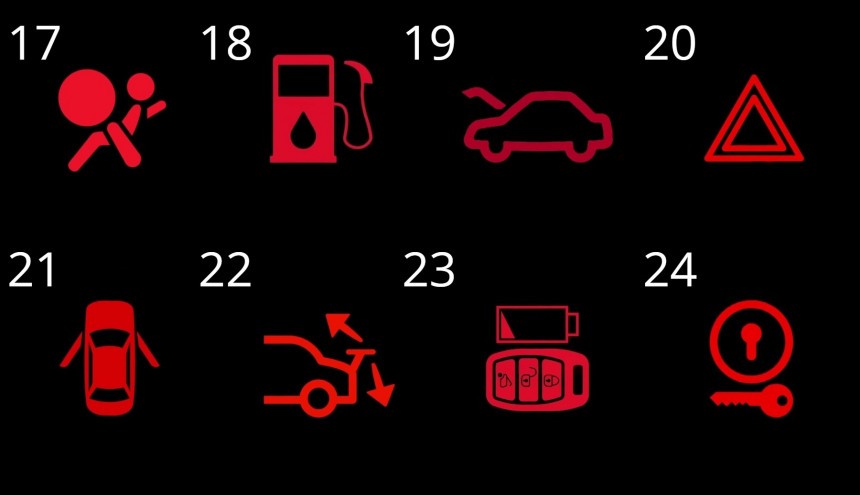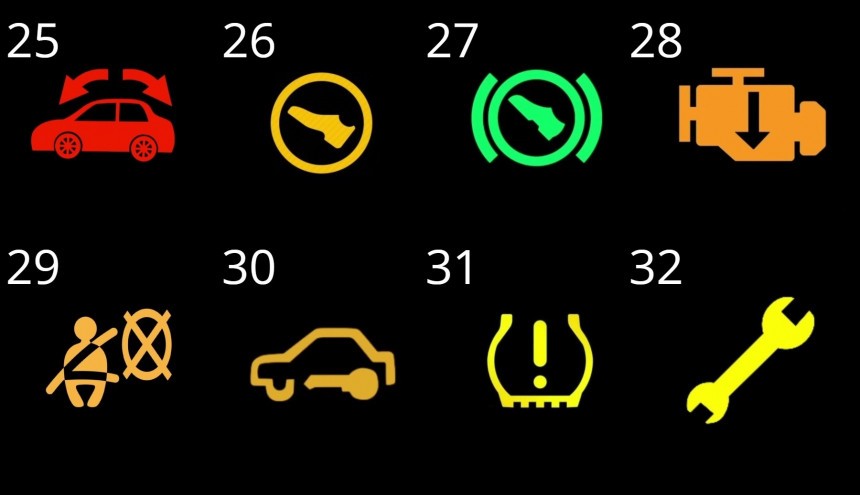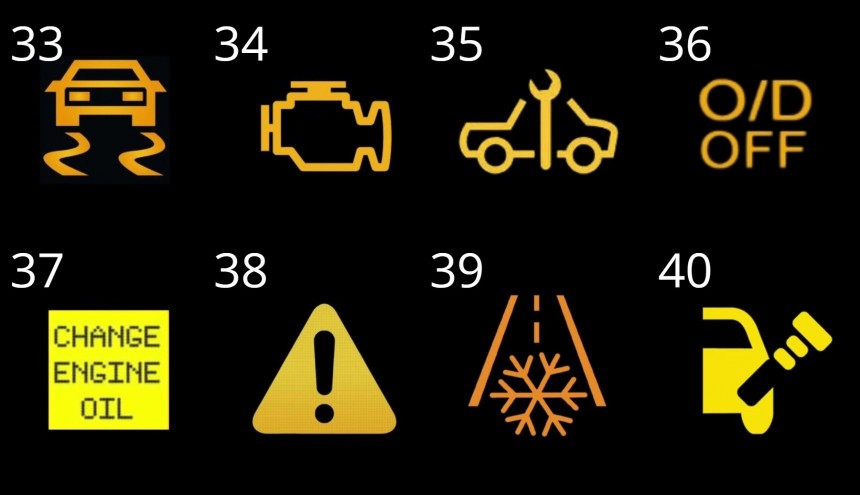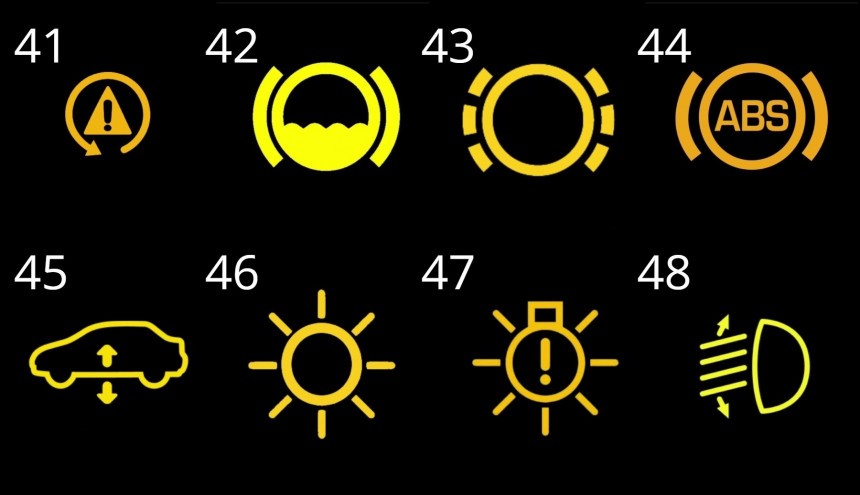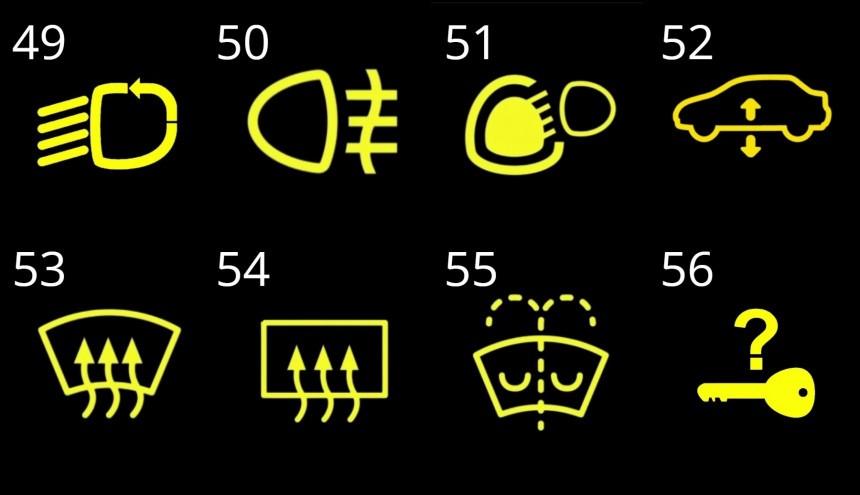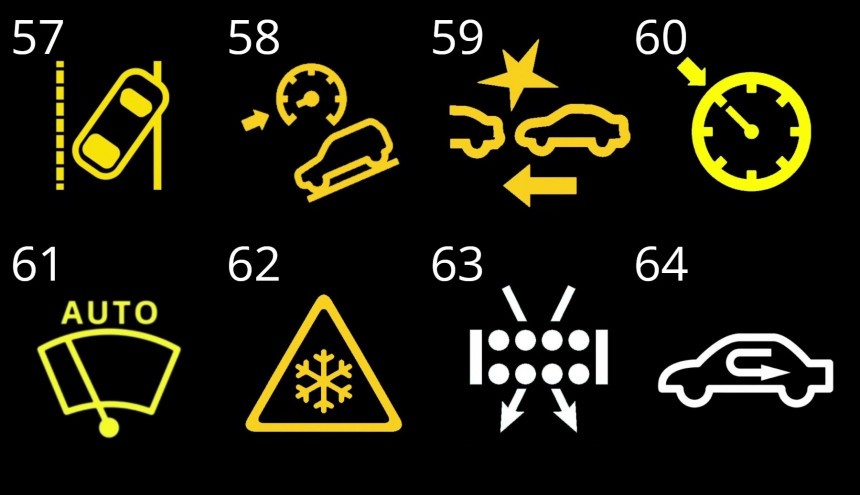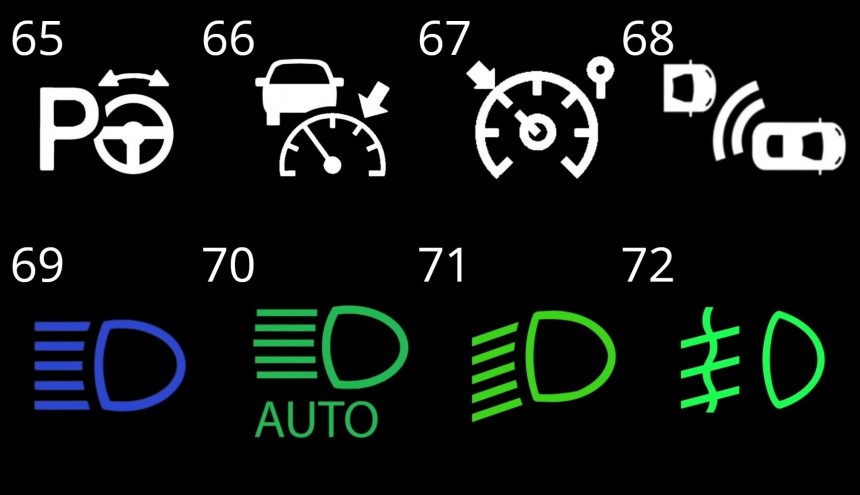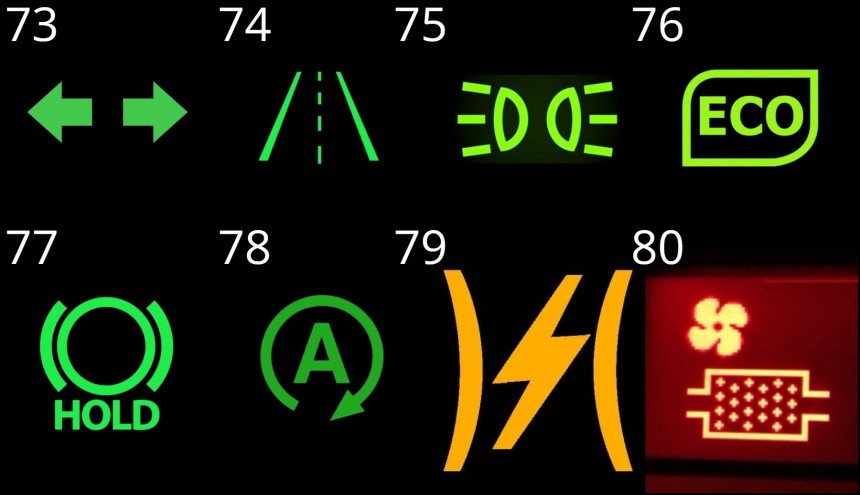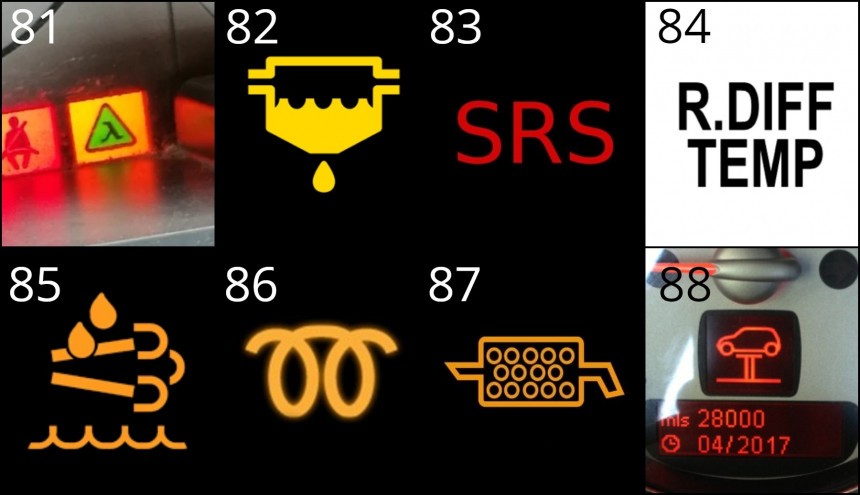An integral part of the dashboard, the instrument cluster was designed with the specific purpose of informing the driver about vehicle-related information. Both good and bad info, that is. From the engine speed and how fast you’re going to electrical system faults and the automatic transmission fluid getting hot, the instrument cluster shows everything of interest to the car’s operator.
You can also think of the instrument cluster as the easiest way a vehicle talks back to its driver, allowing them to stay up to date with the status of the car and provide prior notice on potential issues. The dash lights followed the same evolutionary trend as the whole car, migrating from standard light bulbs to more attractive and efficient LEDs or completely digital warning and indicator lights.
The head-up display is a good example in this sense, a technology developed to project important information such as vehicle speed and engine speed directly on the windshield. Getting back to instrument clusters, their variety increased significantly once car manufacturers developed new technologies regarding safety, engine management, and other miscellaneous equipment. But more importantly, these lights provide critical information that could protect you, your passengers, and other traffic participants by constantly monitoring electrical and mechanical systems.
The number of instrument cluster designs is huge, partly due to the fact that manufacturers personalized warning and indicator lights in their own specific ways. Be that as it may, there is an element of standardization to said lights. That being said, let’s go through the most common and some of the more exceptional dashboard lights out there.
1. Engine Temperature Warning / Coolant Temperature Warning: an internal combustion engine requires fuel to operate, electricity to start and keep the spark plugs firing, oil to be lubricated, and coolant to transfer heat effectively. This warning light comes on for a variety of reasons, including too little or no coolant, a broken water pump, leakage in the system, and radiator issues.
2. Battery Warning: it means the charging system doesn't work properly or the battery is short of power. The 12-volt battery and the alternator are good starting points to investigate, albeit it could also be a wiring issue.
3. Oil Pressure Warning: as expected, this particular symbol indicates the loss of oil pressure, meaning that lubrication is either low or zero. First and foremost, check the oil level with the dipstick. If your car doesn’t have any (looking at you, BMW!), then call the towing services. If the level is correct, take into consideration an internal leak, a clogged filter, a faulty pump, and a bad sensor.
4. Brake Warning: if the symbol includes an exclamation mark, then it indicates an issue with the brake system. In case of a persistent brake warning light, have the issue checked immediately.
5. Transmission Temperature Warning: a transmission could get hot due to low transmission fluid, heavy towing, worn parts, or something a bit more serious. Also bear in mind that it could be an issue with temperature measurement.
6. Seat Belt Indicator: all vehicles in production today have sensors that detect whether the seat belts are latched or unlatched. The three-point seat belt was introduced into series production in 1959 by Swedish automaker Volvo. The three-point design was patented for consumer vehicles in 1955 by Roger Griswold and Hugh DeHaven, yet Volvo engineer Nils Bohlin is credited with inventing the three-point seat belt as we know it today.
7. Power Steering Warning: not surprising anyone, a steering wheel with an exclamation mark next to it indicates a power steering system issue.
8. Steering Lock Warning: a steering wheel with a lock means your steering wheel cannot be moved. A spring-loaded lever locks it in place to prevent anyone from moving the steering wheel without the actual key. The steering lock system deactivates once you turn the key in the ignition.
9. Parking Brake Light: not to be confused with the brake warning light, the parking brake light indicates that your parking brake (a.k.a. emergency brake or handbrake) is engaged. If the light doesn’t turn off after disengaging the parking brake, have the issue investigated by a professional.
10. Trailer Tow Hitch Warning: normally found in pickup trucks, but also in vehicles that can be used for towing trailers/caravans, the trailer tow hitch warning light comes over an issue with the lighting connection, if the tow hitch is unlocked, or if you’re towing an excessively heavy load.
11. Active Braking Assist Warning: also known as distance warning light, the red triangle with a car warning light is specific to Mercedes passenger vehicles (think GLC) and commercial vehicles (think Sprinter). It notifies the driver that the vehicle in front is too close for comfort. Alternatively, it may indicate an obstacle in the road.
12. Catalytic Converter Warning: this indicator light tells the driver there’s something off about the catalytic converter. Always test the oxygen sensors before replacing the catalytic converter.
13. Brake Lights Warning: emphasis on lights rather than light. When this indicator turns on, you should check the operation of all exterior brake lights, including your vehicle’s third brake light.
14. Transmission Warning: a toothed wheel with an exclamation mark indicates an issue with the transmission. From the transmission fluid getting hot to the fluid level being too low and insufficient fluid pressure, all potential issues are bad enough that you should stop driving your vehicle.
15. AWD or 4WD: indicates that all- or four-wheel drive is engaged. Often used interchangeably, AWD and 4WD are – in fact – different. 4WD is usually specific to body-on-frame vehicles such as pickup trucks and off-road warriors like the Ford Bronco, Jeep Wrangler, and Toyota Land Cruiser.
16. AWD Lock or 4WD Lock: either symbol means that power is continuously sent to all four wheels evenly. In other words, all four wheels rotate at the same speed. Never use lock mode on dry roads or at high speeds because it can lead to serious damage to the all-wheel- or four-wheel-drive system.
17. Airbag Indicator: if this light doesn’t go away after a few moments following engine startup, that may indicate a serious issue with one of the car’s airbags. In case of a crash, said airbag may not deploy, thus increasing the risk of injury.
18. Low Fuel Warning: if the icon resembling a fuel pump with a hose lights up on your vehicle’s instrument cluster, that’s a sign you should fill ‘er up with dinosaur juice as soon as possible. You should never drive a vehicle until this light comes on because there is a chance for the sludge at the bottom of the fuel tank to get past the filter, thus clogging up the rather pricey fuel injectors.
19. Hood Open: indicates the hood isn’t closed all the way. If the problem stems from the latch/striker assembly, the warning light will persist. You can still drive your car with the hood partially latched to the nearest service location, but keep it nice and sensible if you don’t want the windshield to get badly damaged or the hood to fly right off.
20. Hazard Warning Lights: the hazard warning lights have many uses. Certain drivers use said hazard warning lights when parked illegally. Better drivers use it to warn those behind of standstill traffic or to signal their presence in bad weather conditions. As a rule of thumb, different countries use the hazard warning lights differently.
21. Door Ajar: one or more of the vehicle’s doors are open or not closed securely.
22. Rear Spoiler Indicator: this light comes on when the rear spoiler goes up/down, or when there’s an issue with said spoiler. In case of an issue, the instrument cluster should provide a message in this sense as well, not only the symbol.
23. Key Fob Battery Low: exactly as it says on the tin.
24. Ignition Switch Warning: indicates an issue with the vehicle’s ignition system, ignition key, or the key fob in the case of vehicles equipped with push-button start with keyless access.
25. Convertible Roof Warning: this symbol lights up while the roof is opening or closing. If the light doesn’t turn off, that means the roof isn’t fully opened or closed, or there is a fault that needs to be inspected by a service technician.
26. Press Clutch Pedal: this light comes on to inform the vehicle operator that the clutch needs to be pressed before starting the engine. Of course, it applies to manual vehicles only.
27. Press Brake Pedal: be it a torque-converter automatic like ZF’s 8HP, a dual-clutch gearbox, a continuously variable transmission, or an automated manual, this symbol is exclusive to vehicles with two rather than three pedals. The symbol informs the driver to press the brake pedal in order to start the vehicle and to shift out of park.
28. Reduced Engine Power Warning: the engine control unit (alternatively dubbed engine control module) has limited engine power to avoid engine damage. This light can be triggered by a fault with the electronic throttle actuator control system, fan clutch, or the fuel system, among others.
29. Side Airbag Warning: designed to reduce the risk of lower abdomen and pelvic injuries, side airbags shouldn’t be confused with side curtain airbags. This light comes on if a problem has been detected in the system, meaning that one of the side airbags may not deploy in the event of a crash.
30. Immobilizer Warning: this light turns on if the anti-theft system doesn’t recognize the key used to start the vehicle, the battery in the key fob is too low, or something that requires specialized help.
31. Tire Pressure Warning: this light warns about dangerously low air pressure in at least one of the vehicle’s tires. Modern tire pressure monitoring systems also show each tire’s air pressure in bars, pounds per square inch, or kilopascals. The ideal tire pressures for your vehicle are typically found on a sticker affixed to the driver-side door jamb.
32. Powertrain Fault Light: the spanner symbol is typically used by Ford to indicate problems with the powertrain or drivetrain. This warning is often joined by a failsafe message, which informs the driver of the vehicle going into limp mode.
33. Traction Control: this light indicates that the system is active or that traction control has intervened to keep the car in check. If the traction control symbol also reads OFF, that means – obviously enough – that TCS is turned off.
34. Check Engine: standing for a problem that requires immediate attention, the check engine light could mean a helluva lot of stuff. Get the vehicle professionally diagnosed with an OBD2 auto diagnostic tool to pinpoint the root cause.
35. Service Vehicle Soon: a car silhouette with a spanner bang in the middle of said vehicle means a relatively minor issue affecting the anti-lock brakes and/or hydraulic system, electronic suspension system, or the traction control system. Alternately, the SERVICE ENGINE SOON light or warning message indicates a minor engine problem.
36. O/D Off Indicator: overdrive off means that the transmission’s overdrive gear isn’t engaged. This leads to higher engine speeds (i.e., revolutions per minute), resulting in higher fuel consumption. The overdrive function should be turned off when you’re towing or hauling, overtaking, and when you’re driving downhill for engine braking.
37. Change Engine Oil Message: this could mean low oil level or low oil pressure. In any case, make sure to change the engine oil ASAP.
38. Master Warning Light: a triangle with an exclamation mark is the vehicle’s way of notifying the driver about one or more problems with said vehicle’s advanced systems. This warning light is usually joined by a more detailed warning message, although an OBD2 diagnostic tool is obviously required for identifying the root cause.
39. Frost Warning: also known as the icy road warning light, the frost warning is self-explanatory.
40. Gas Cap Warning: check if the gas cap is properly tightened. A leak in the fuel system can trigger this symbol to light up. If a properly tightened gas cap doesn’t fix it, you should have a certified technician determine the cause.
41. ESP Fault or Traction Control Fault: although it looks extremely similar to the master warning light, the electronic stability program fault or traction control system malfunction light shouldn’t concern you as much as the master warning light. It does indicate a problem, though, which is why a service tech should have your vehicle checked.
42. Brake Fluid Warning: either the brake fluid level has got low or there’s an issue with the sensor that measures the brake fluid level. If you intend to top it off by yourself, pay attention to the brake fluid DOT number intended for your vehicle.
43. Brake Pad Warning: as implied, the brake pads are getting really thin, meaning you should replace them as soon as possible for peace of mind.
44. ABS Warning: ABS stands for anti-lock brakes rather than airbag system. The anti-lock braking system warning light alerts of a potential issue affecting the ABS system. Similarly, this light may indicate a defective sensor or a wiring issue.
45. Air Suspension Warning: indicates either a leak or inflation issue with at least one of the air suspension units. Have a certified technician look into what’s actually wrong with the system.
46. Sun Symbol: although not obvious, the sun-like symbol indicates an exterior lighting issue.
47. Exterior Light Fault: based on the sun-shaped symbol, the variant with an exclamation mark has the very same meaning. Have every exterior light inspected and every defective bulb replaced.
48. Headlight Range Control Issue: if this light comes on, your car’s electronic brain may have already disabled the headlight range control system in order to prevent any additional damage.
49. Adaptive Light System Indicator: by adaptive, automakers refer to lighting systems that can adjust the beam to specific driving scenarios. The Citroen DS Series 3 introduced directional headlights to mass-market automobiles back in 1967. The Tucker 48 was the first application of this technology in the automotive realm. Only 51 were ever made.
50. Rear Fog Lights: a legal requirement on all vehicles, rear fog lights should be used when visibility is seriously reduced. The rear fog lights make your vehicle more visible to the vehicles behind you, thus reducing the risk of a crash.
51. Rain and Light Sensor Warning: this symbol means that your car is experiencing an issue with the sensor tasked with turning the headlights and windshield wipers on and off automatically. In case of said warning light, you can still turn the headlights and wipers on or off manually.
52. Air Suspension Warning: usually reserved for high-end vehicles (for example, certain Mercedes-Benz vehicles and Ram pickup trucks), airbag suspension reduces sway and body roll in all scenarios. In case of a warning light, have a service technician specialized in your vehicle’s make check the diagnostic trouble codes and the airbag suspension. This kind of suspension comes in pairs: either one for the rear axle or two for both.
53. Windshield Defrost: if the window’s shape is curved, that’s the indicator for the windshield defroster/defogger.
54. Rear Window Defrost: if the shape is rectangular, that stands for the rear window defroster/defogger.
55. Windshield Washer Fluid Reminder: the windshield washer fluid level is getting extremely low. Before topping up, make sure you don’t confuse the washer fluid reservoir with the brake fluid reservoir. A faulty washer fluid level sensor may keep the light on.
56. Key Fob Not Detected: vehicles equipped with keyless ignition won’t start without the correct key fob. Even if the key fob’s battery goes completely flat, you can start the vehicle by placing the key fob close to the area designated in the owner’s manual (usually close to or right on the engine start/stop button). You can open the driver’s door by using the key fob’s physical key.
57. Lane Departure Warning: this warning light comes up if the vehicle strays from its lane or the driver changes lanes without using the turn signals. Lane Departure Warning shouldn’t be confused with Lane Keeping Assist because the latter can keep the vehicle from moving out of its lane by applying steering input.
58. Hill Descent Control: this system steadies the vehicle’s speed while driving downhill.
59. Forward Collision Warning: warns the driver when their vehicle is too close to the vehicle, pedestrian, or obstacle in front. Vehicles equipped with automatic emergency braking apply the brakes automatically to avoid or mitigate a crash.
60. Cruise Control: this symbol turns when the cruise control system is active. The yellow symbol turns green once the driver selects a speed.
61. Auto Windshield Wiping: the windshield wipers are in operation in automatic mode.
62. Winter Mode: not to be confused with the frost warning, winter mode prevents the tires from spinning in winter driving conditions (ice or/and snow on the road) by starting an automatic-equipped vehicle in second or third gear.
63. Engine Air Filter Warning: an overly dirty engine air filter (or filters) automatically means that less air is going into the engine, thus leading to reduced engine performance. If this light comes on, the filter definitely needs to be replaced.
64. Cabin Air Recirculation: the ventilation system recirculates air from the cabin rather than using fresh air from outside. This feature is best used during the summer months to cool the interior that much quicker. You don’t want to use recirculated air in the winter because it traps humidity in the cabin, leading to extremely foggy windows.
65. Park Assist: a P with a steering wheel next to it indicates that the parking assistance system is turned on. Said parking assistance system can steer the vehicle into a parking spot. The driver is still required to use the accelerator and brake as indicated by the instrument cluster. This symbol shouldn’t be confused with the P and triangle, which stands for parking sensors rather than assist.
66. Adaptive Cruise Control: similar to cruise control, the adaptive version means that you can choose a set distance from the vehicle ahead. Certain adaptive cruise control systems further sweeten the deal with something called stop & go, meaning that the vehicle can stop and accelerate back to the designated speed by itself, all while keeping an eye out for the vehicles in front.
67. Speed Limiter: the vehicle won’t exceed the maximum speed set by the driver.
68. Blind Spot Warning: detects vehicles located to the rear and side while notifying the driver of their presence. Ford advertises this feature as BLIS (Blind Spot Information System). If the blind spot warning light persists, that may indicate a problem with the blind spot warning system.
69. High Beam: the high beam indicator means exactly what you expect it to mean.
70. Auto High Beam: as implied, certain vehicles are equipped with a system that alternates between the high and low beams automatically. The system knows when to switch between them by detecting the headlights of oncoming vehicles.
71. Low Beam: the low beam indicator means – no surprises here – that the dipped beam is on.
72. Front Fog Lights: intended to be used when you can’t see more than 100 meters (that would be 328 feet) in front of the vehicle, the front fog lights work their magic in foggy or whiteout conditions.
73. Turn Signal Indicators: always use your turn signals when changing lanes or direction, even if your vehicle wears BMW badges inside and out. And no, there’s no such thing as blinker fluid.
74. Lane Assist: a system that detects the lane markers on the road via the front-facing camera, lane assist also keeps the vehicle between said lanes. If the car strays from its lane, the driver is alerted both visually and audibly to take action.
75. Position Light Indicator: known as parking lights in the US of A or front sidelights in the UK, position lights provide conspicuity to standing vehicles. By design, position lights use less electricity than the low and high beams.
76. Eco Mode: in internal combustion-engined vehicles, Eco Mode calibrates a plethora of systems to maximize fuel efficiency at the expense of throttle response and kickdown response. The ECO driving indicator, on the other hand, coaches the driver on how to drive more efficiently.
77. Brake Hold: a feature that allows the driver to take the foot off the brake pedal while stopped at a light or in standstill traffic. Brake hold is automatically disengaged once you apply some throttle to get the vehicle moving again.
78. Auto Start/Stop: in a manual vehicle, the engine starts back the moment you press the clutch pedal to shift into first. In an automatic vehicle, the engine restarts once you lift your foot off the brake. Stop/Start won’t intervene when the engine is cold or when the battery is close to going flat.
79. Electronic Throttle Control Warning: briefly enabled when the driver starts the engine, this light may also indicate a malfunction with the vehicle’s electronic throttle body or the ETC system. Think electromagnetic interference, iffy wires, etc.
80. Cabin Air Filter Warning: a common sight in BMW vehicles, the cabin air filter (a.k.a. microfilter) warning light is another way of saying replace said air filter as soon as possible.
81. Lambda Warning: not only does this warning light include a letter from the Greek alphabet, but it also combines the colors green, yellow, and black. In case this warning light turns on and persists, that means the oxygen sensor has gone kaput.
82. Fuel Filter Level Warning: exclusive to diesel vehicles, the fuel filter level warning light indicates excess water in the fuel filter water trap.
83. SRS Warning: to whom it may concern, SRS stands for supplemental restraint system. If the SRS warning light doesn’t go away, that means trouble with either the airbags or the seat belts.
84. Rear Differential Oil Temperature Warning: ignoring this warning light can cause serious damage to the rear diff of your vehicle.
85. Diesel Exhaust Fluid Warning: better known as AdBlue in Europe, diesel exhaust fluid makes diesel engines that much cleaner. This warning light means that you’re low on exhaust fluid.
86. Glow Plug Warning: also exclusive to diesels, the glow plug warning light indicates an issue with the glow plugs or the control system.
87. Diesel Particulate Filter Warning: either the DPF is full and needs regeneration/replacement, or the diesel particulate filter experiences a problem that only a specialist can diagnose.
88. Car on Lift Warning: lovingly dubbed the red car lift of death by enthusiasts of the German marque, this warning light indicates one too many things. From the electronics to the fuel pump, brake pads, ignition, and starter motor, this warning light could mean anything. Needless to say, have a BMW service technician diagnose the issue.
89. Auto Glide Control: the following indicator and warning lights are specific to hybrid and electric vehicles. Auto Glide Control reduces deceleration force, thus allowing the vehicle to coast a little more.
90. Battery Charge Level Warning: charge the vehicle’s high-voltage battery soon, or else.
91. Battery Temperature Warning: if you’re not a gambling man (or woman), then pull over immediately to let the HV battery cool off.
92. Eco Mode: similar to internal combustion-only vehicles, Eco Mode for hybrids and EVs reduces overall performance in the name of efficiency.
93. EV Mode: applying to both hybrids and plug-in hybrids, EV Mode stands for zero-emission driving. The 2024 model year Chevrolet Corvette E-Ray, for example, has something called Stealth Mode for quiet driving at speeds up to 45 mph (72 kph).
94. General Electric Issue: a vehicle’s silhouette with an exclamation mark in the middle is – rather unfortunately – broad in meaning. It could be an issue with the electric motor, battery, wiring, electronics, or something related to software.
95. General Issue: even broader than the general electric issue warning light, general issue means that you’re not qualified to diagnose said issue.
96. Low Battery: similar to the warning light we talked about a little while ago, the low battery indicator applies to electric vehicles exclusively.
97. Pedestrian Warning: as implied, the vehicle warns the driver of the pedestrian in front of said vehicle. The automatic emergency braking system will step in if no action is taken by the driver.
98. Limited Power: indicates a potentially serious issue, including extreme battery temperatures.
99. Ready to Drive: because electric vehicles are inherently silent, the Ready to Drive symbol tells the driver whether the EV is turned on or not.
100. Regenerative Braking System: an indicator that lights up when the regenerative braking system is active or said vehicle performs regenerative braking. This system charges the high-voltage battery while slowing down the vehicle.
101. Regenerative Braking System Warning: remember the brake warning symbol? Certain manufacturers also use it to indicate a problem with the regenerative braking system. More common, however, is the RBS symbol in yellow.
102. External Sound System Issue: every hybrid, plug-in hybrid, and electric vehicle produced nowadays comes with an external sound system to alert pedestrians. If this indicator comes on, it means the system doesn’t work as intended.
The head-up display is a good example in this sense, a technology developed to project important information such as vehicle speed and engine speed directly on the windshield. Getting back to instrument clusters, their variety increased significantly once car manufacturers developed new technologies regarding safety, engine management, and other miscellaneous equipment. But more importantly, these lights provide critical information that could protect you, your passengers, and other traffic participants by constantly monitoring electrical and mechanical systems.
The number of instrument cluster designs is huge, partly due to the fact that manufacturers personalized warning and indicator lights in their own specific ways. Be that as it may, there is an element of standardization to said lights. That being said, let’s go through the most common and some of the more exceptional dashboard lights out there.
2. Battery Warning: it means the charging system doesn't work properly or the battery is short of power. The 12-volt battery and the alternator are good starting points to investigate, albeit it could also be a wiring issue.
3. Oil Pressure Warning: as expected, this particular symbol indicates the loss of oil pressure, meaning that lubrication is either low or zero. First and foremost, check the oil level with the dipstick. If your car doesn’t have any (looking at you, BMW!), then call the towing services. If the level is correct, take into consideration an internal leak, a clogged filter, a faulty pump, and a bad sensor.
4. Brake Warning: if the symbol includes an exclamation mark, then it indicates an issue with the brake system. In case of a persistent brake warning light, have the issue checked immediately.
5. Transmission Temperature Warning: a transmission could get hot due to low transmission fluid, heavy towing, worn parts, or something a bit more serious. Also bear in mind that it could be an issue with temperature measurement.
6. Seat Belt Indicator: all vehicles in production today have sensors that detect whether the seat belts are latched or unlatched. The three-point seat belt was introduced into series production in 1959 by Swedish automaker Volvo. The three-point design was patented for consumer vehicles in 1955 by Roger Griswold and Hugh DeHaven, yet Volvo engineer Nils Bohlin is credited with inventing the three-point seat belt as we know it today.
7. Power Steering Warning: not surprising anyone, a steering wheel with an exclamation mark next to it indicates a power steering system issue.
8. Steering Lock Warning: a steering wheel with a lock means your steering wheel cannot be moved. A spring-loaded lever locks it in place to prevent anyone from moving the steering wheel without the actual key. The steering lock system deactivates once you turn the key in the ignition.
10. Trailer Tow Hitch Warning: normally found in pickup trucks, but also in vehicles that can be used for towing trailers/caravans, the trailer tow hitch warning light comes over an issue with the lighting connection, if the tow hitch is unlocked, or if you’re towing an excessively heavy load.
11. Active Braking Assist Warning: also known as distance warning light, the red triangle with a car warning light is specific to Mercedes passenger vehicles (think GLC) and commercial vehicles (think Sprinter). It notifies the driver that the vehicle in front is too close for comfort. Alternatively, it may indicate an obstacle in the road.
12. Catalytic Converter Warning: this indicator light tells the driver there’s something off about the catalytic converter. Always test the oxygen sensors before replacing the catalytic converter.
13. Brake Lights Warning: emphasis on lights rather than light. When this indicator turns on, you should check the operation of all exterior brake lights, including your vehicle’s third brake light.
14. Transmission Warning: a toothed wheel with an exclamation mark indicates an issue with the transmission. From the transmission fluid getting hot to the fluid level being too low and insufficient fluid pressure, all potential issues are bad enough that you should stop driving your vehicle.
15. AWD or 4WD: indicates that all- or four-wheel drive is engaged. Often used interchangeably, AWD and 4WD are – in fact – different. 4WD is usually specific to body-on-frame vehicles such as pickup trucks and off-road warriors like the Ford Bronco, Jeep Wrangler, and Toyota Land Cruiser.
16. AWD Lock or 4WD Lock: either symbol means that power is continuously sent to all four wheels evenly. In other words, all four wheels rotate at the same speed. Never use lock mode on dry roads or at high speeds because it can lead to serious damage to the all-wheel- or four-wheel-drive system.
18. Low Fuel Warning: if the icon resembling a fuel pump with a hose lights up on your vehicle’s instrument cluster, that’s a sign you should fill ‘er up with dinosaur juice as soon as possible. You should never drive a vehicle until this light comes on because there is a chance for the sludge at the bottom of the fuel tank to get past the filter, thus clogging up the rather pricey fuel injectors.
19. Hood Open: indicates the hood isn’t closed all the way. If the problem stems from the latch/striker assembly, the warning light will persist. You can still drive your car with the hood partially latched to the nearest service location, but keep it nice and sensible if you don’t want the windshield to get badly damaged or the hood to fly right off.
20. Hazard Warning Lights: the hazard warning lights have many uses. Certain drivers use said hazard warning lights when parked illegally. Better drivers use it to warn those behind of standstill traffic or to signal their presence in bad weather conditions. As a rule of thumb, different countries use the hazard warning lights differently.
21. Door Ajar: one or more of the vehicle’s doors are open or not closed securely.
22. Rear Spoiler Indicator: this light comes on when the rear spoiler goes up/down, or when there’s an issue with said spoiler. In case of an issue, the instrument cluster should provide a message in this sense as well, not only the symbol.
23. Key Fob Battery Low: exactly as it says on the tin.
24. Ignition Switch Warning: indicates an issue with the vehicle’s ignition system, ignition key, or the key fob in the case of vehicles equipped with push-button start with keyless access.
26. Press Clutch Pedal: this light comes on to inform the vehicle operator that the clutch needs to be pressed before starting the engine. Of course, it applies to manual vehicles only.
27. Press Brake Pedal: be it a torque-converter automatic like ZF’s 8HP, a dual-clutch gearbox, a continuously variable transmission, or an automated manual, this symbol is exclusive to vehicles with two rather than three pedals. The symbol informs the driver to press the brake pedal in order to start the vehicle and to shift out of park.
28. Reduced Engine Power Warning: the engine control unit (alternatively dubbed engine control module) has limited engine power to avoid engine damage. This light can be triggered by a fault with the electronic throttle actuator control system, fan clutch, or the fuel system, among others.
29. Side Airbag Warning: designed to reduce the risk of lower abdomen and pelvic injuries, side airbags shouldn’t be confused with side curtain airbags. This light comes on if a problem has been detected in the system, meaning that one of the side airbags may not deploy in the event of a crash.
30. Immobilizer Warning: this light turns on if the anti-theft system doesn’t recognize the key used to start the vehicle, the battery in the key fob is too low, or something that requires specialized help.
31. Tire Pressure Warning: this light warns about dangerously low air pressure in at least one of the vehicle’s tires. Modern tire pressure monitoring systems also show each tire’s air pressure in bars, pounds per square inch, or kilopascals. The ideal tire pressures for your vehicle are typically found on a sticker affixed to the driver-side door jamb.
32. Powertrain Fault Light: the spanner symbol is typically used by Ford to indicate problems with the powertrain or drivetrain. This warning is often joined by a failsafe message, which informs the driver of the vehicle going into limp mode.
34. Check Engine: standing for a problem that requires immediate attention, the check engine light could mean a helluva lot of stuff. Get the vehicle professionally diagnosed with an OBD2 auto diagnostic tool to pinpoint the root cause.
35. Service Vehicle Soon: a car silhouette with a spanner bang in the middle of said vehicle means a relatively minor issue affecting the anti-lock brakes and/or hydraulic system, electronic suspension system, or the traction control system. Alternately, the SERVICE ENGINE SOON light or warning message indicates a minor engine problem.
36. O/D Off Indicator: overdrive off means that the transmission’s overdrive gear isn’t engaged. This leads to higher engine speeds (i.e., revolutions per minute), resulting in higher fuel consumption. The overdrive function should be turned off when you’re towing or hauling, overtaking, and when you’re driving downhill for engine braking.
37. Change Engine Oil Message: this could mean low oil level or low oil pressure. In any case, make sure to change the engine oil ASAP.
38. Master Warning Light: a triangle with an exclamation mark is the vehicle’s way of notifying the driver about one or more problems with said vehicle’s advanced systems. This warning light is usually joined by a more detailed warning message, although an OBD2 diagnostic tool is obviously required for identifying the root cause.
39. Frost Warning: also known as the icy road warning light, the frost warning is self-explanatory.
40. Gas Cap Warning: check if the gas cap is properly tightened. A leak in the fuel system can trigger this symbol to light up. If a properly tightened gas cap doesn’t fix it, you should have a certified technician determine the cause.
42. Brake Fluid Warning: either the brake fluid level has got low or there’s an issue with the sensor that measures the brake fluid level. If you intend to top it off by yourself, pay attention to the brake fluid DOT number intended for your vehicle.
43. Brake Pad Warning: as implied, the brake pads are getting really thin, meaning you should replace them as soon as possible for peace of mind.
44. ABS Warning: ABS stands for anti-lock brakes rather than airbag system. The anti-lock braking system warning light alerts of a potential issue affecting the ABS system. Similarly, this light may indicate a defective sensor or a wiring issue.
45. Air Suspension Warning: indicates either a leak or inflation issue with at least one of the air suspension units. Have a certified technician look into what’s actually wrong with the system.
46. Sun Symbol: although not obvious, the sun-like symbol indicates an exterior lighting issue.
47. Exterior Light Fault: based on the sun-shaped symbol, the variant with an exclamation mark has the very same meaning. Have every exterior light inspected and every defective bulb replaced.
48. Headlight Range Control Issue: if this light comes on, your car’s electronic brain may have already disabled the headlight range control system in order to prevent any additional damage.
50. Rear Fog Lights: a legal requirement on all vehicles, rear fog lights should be used when visibility is seriously reduced. The rear fog lights make your vehicle more visible to the vehicles behind you, thus reducing the risk of a crash.
51. Rain and Light Sensor Warning: this symbol means that your car is experiencing an issue with the sensor tasked with turning the headlights and windshield wipers on and off automatically. In case of said warning light, you can still turn the headlights and wipers on or off manually.
52. Air Suspension Warning: usually reserved for high-end vehicles (for example, certain Mercedes-Benz vehicles and Ram pickup trucks), airbag suspension reduces sway and body roll in all scenarios. In case of a warning light, have a service technician specialized in your vehicle’s make check the diagnostic trouble codes and the airbag suspension. This kind of suspension comes in pairs: either one for the rear axle or two for both.
53. Windshield Defrost: if the window’s shape is curved, that’s the indicator for the windshield defroster/defogger.
54. Rear Window Defrost: if the shape is rectangular, that stands for the rear window defroster/defogger.
55. Windshield Washer Fluid Reminder: the windshield washer fluid level is getting extremely low. Before topping up, make sure you don’t confuse the washer fluid reservoir with the brake fluid reservoir. A faulty washer fluid level sensor may keep the light on.
56. Key Fob Not Detected: vehicles equipped with keyless ignition won’t start without the correct key fob. Even if the key fob’s battery goes completely flat, you can start the vehicle by placing the key fob close to the area designated in the owner’s manual (usually close to or right on the engine start/stop button). You can open the driver’s door by using the key fob’s physical key.
58. Hill Descent Control: this system steadies the vehicle’s speed while driving downhill.
59. Forward Collision Warning: warns the driver when their vehicle is too close to the vehicle, pedestrian, or obstacle in front. Vehicles equipped with automatic emergency braking apply the brakes automatically to avoid or mitigate a crash.
60. Cruise Control: this symbol turns when the cruise control system is active. The yellow symbol turns green once the driver selects a speed.
61. Auto Windshield Wiping: the windshield wipers are in operation in automatic mode.
62. Winter Mode: not to be confused with the frost warning, winter mode prevents the tires from spinning in winter driving conditions (ice or/and snow on the road) by starting an automatic-equipped vehicle in second or third gear.
63. Engine Air Filter Warning: an overly dirty engine air filter (or filters) automatically means that less air is going into the engine, thus leading to reduced engine performance. If this light comes on, the filter definitely needs to be replaced.
64. Cabin Air Recirculation: the ventilation system recirculates air from the cabin rather than using fresh air from outside. This feature is best used during the summer months to cool the interior that much quicker. You don’t want to use recirculated air in the winter because it traps humidity in the cabin, leading to extremely foggy windows.
66. Adaptive Cruise Control: similar to cruise control, the adaptive version means that you can choose a set distance from the vehicle ahead. Certain adaptive cruise control systems further sweeten the deal with something called stop & go, meaning that the vehicle can stop and accelerate back to the designated speed by itself, all while keeping an eye out for the vehicles in front.
67. Speed Limiter: the vehicle won’t exceed the maximum speed set by the driver.
68. Blind Spot Warning: detects vehicles located to the rear and side while notifying the driver of their presence. Ford advertises this feature as BLIS (Blind Spot Information System). If the blind spot warning light persists, that may indicate a problem with the blind spot warning system.
69. High Beam: the high beam indicator means exactly what you expect it to mean.
70. Auto High Beam: as implied, certain vehicles are equipped with a system that alternates between the high and low beams automatically. The system knows when to switch between them by detecting the headlights of oncoming vehicles.
71. Low Beam: the low beam indicator means – no surprises here – that the dipped beam is on.
72. Front Fog Lights: intended to be used when you can’t see more than 100 meters (that would be 328 feet) in front of the vehicle, the front fog lights work their magic in foggy or whiteout conditions.
74. Lane Assist: a system that detects the lane markers on the road via the front-facing camera, lane assist also keeps the vehicle between said lanes. If the car strays from its lane, the driver is alerted both visually and audibly to take action.
75. Position Light Indicator: known as parking lights in the US of A or front sidelights in the UK, position lights provide conspicuity to standing vehicles. By design, position lights use less electricity than the low and high beams.
76. Eco Mode: in internal combustion-engined vehicles, Eco Mode calibrates a plethora of systems to maximize fuel efficiency at the expense of throttle response and kickdown response. The ECO driving indicator, on the other hand, coaches the driver on how to drive more efficiently.
77. Brake Hold: a feature that allows the driver to take the foot off the brake pedal while stopped at a light or in standstill traffic. Brake hold is automatically disengaged once you apply some throttle to get the vehicle moving again.
78. Auto Start/Stop: in a manual vehicle, the engine starts back the moment you press the clutch pedal to shift into first. In an automatic vehicle, the engine restarts once you lift your foot off the brake. Stop/Start won’t intervene when the engine is cold or when the battery is close to going flat.
79. Electronic Throttle Control Warning: briefly enabled when the driver starts the engine, this light may also indicate a malfunction with the vehicle’s electronic throttle body or the ETC system. Think electromagnetic interference, iffy wires, etc.
80. Cabin Air Filter Warning: a common sight in BMW vehicles, the cabin air filter (a.k.a. microfilter) warning light is another way of saying replace said air filter as soon as possible.
81. Lambda Warning: not only does this warning light include a letter from the Greek alphabet, but it also combines the colors green, yellow, and black. In case this warning light turns on and persists, that means the oxygen sensor has gone kaput.
82. Fuel Filter Level Warning: exclusive to diesel vehicles, the fuel filter level warning light indicates excess water in the fuel filter water trap.
83. SRS Warning: to whom it may concern, SRS stands for supplemental restraint system. If the SRS warning light doesn’t go away, that means trouble with either the airbags or the seat belts.
84. Rear Differential Oil Temperature Warning: ignoring this warning light can cause serious damage to the rear diff of your vehicle.
85. Diesel Exhaust Fluid Warning: better known as AdBlue in Europe, diesel exhaust fluid makes diesel engines that much cleaner. This warning light means that you’re low on exhaust fluid.
86. Glow Plug Warning: also exclusive to diesels, the glow plug warning light indicates an issue with the glow plugs or the control system.
87. Diesel Particulate Filter Warning: either the DPF is full and needs regeneration/replacement, or the diesel particulate filter experiences a problem that only a specialist can diagnose.
88. Car on Lift Warning: lovingly dubbed the red car lift of death by enthusiasts of the German marque, this warning light indicates one too many things. From the electronics to the fuel pump, brake pads, ignition, and starter motor, this warning light could mean anything. Needless to say, have a BMW service technician diagnose the issue.
89. Auto Glide Control: the following indicator and warning lights are specific to hybrid and electric vehicles. Auto Glide Control reduces deceleration force, thus allowing the vehicle to coast a little more.
90. Battery Charge Level Warning: charge the vehicle’s high-voltage battery soon, or else.
91. Battery Temperature Warning: if you’re not a gambling man (or woman), then pull over immediately to let the HV battery cool off.
92. Eco Mode: similar to internal combustion-only vehicles, Eco Mode for hybrids and EVs reduces overall performance in the name of efficiency.
93. EV Mode: applying to both hybrids and plug-in hybrids, EV Mode stands for zero-emission driving. The 2024 model year Chevrolet Corvette E-Ray, for example, has something called Stealth Mode for quiet driving at speeds up to 45 mph (72 kph).
94. General Electric Issue: a vehicle’s silhouette with an exclamation mark in the middle is – rather unfortunately – broad in meaning. It could be an issue with the electric motor, battery, wiring, electronics, or something related to software.
95. General Issue: even broader than the general electric issue warning light, general issue means that you’re not qualified to diagnose said issue.
96. Low Battery: similar to the warning light we talked about a little while ago, the low battery indicator applies to electric vehicles exclusively.
97. Pedestrian Warning: as implied, the vehicle warns the driver of the pedestrian in front of said vehicle. The automatic emergency braking system will step in if no action is taken by the driver.
98. Limited Power: indicates a potentially serious issue, including extreme battery temperatures.
99. Ready to Drive: because electric vehicles are inherently silent, the Ready to Drive symbol tells the driver whether the EV is turned on or not.
100. Regenerative Braking System: an indicator that lights up when the regenerative braking system is active or said vehicle performs regenerative braking. This system charges the high-voltage battery while slowing down the vehicle.
101. Regenerative Braking System Warning: remember the brake warning symbol? Certain manufacturers also use it to indicate a problem with the regenerative braking system. More common, however, is the RBS symbol in yellow.
102. External Sound System Issue: every hybrid, plug-in hybrid, and electric vehicle produced nowadays comes with an external sound system to alert pedestrians. If this indicator comes on, it means the system doesn’t work as intended.
